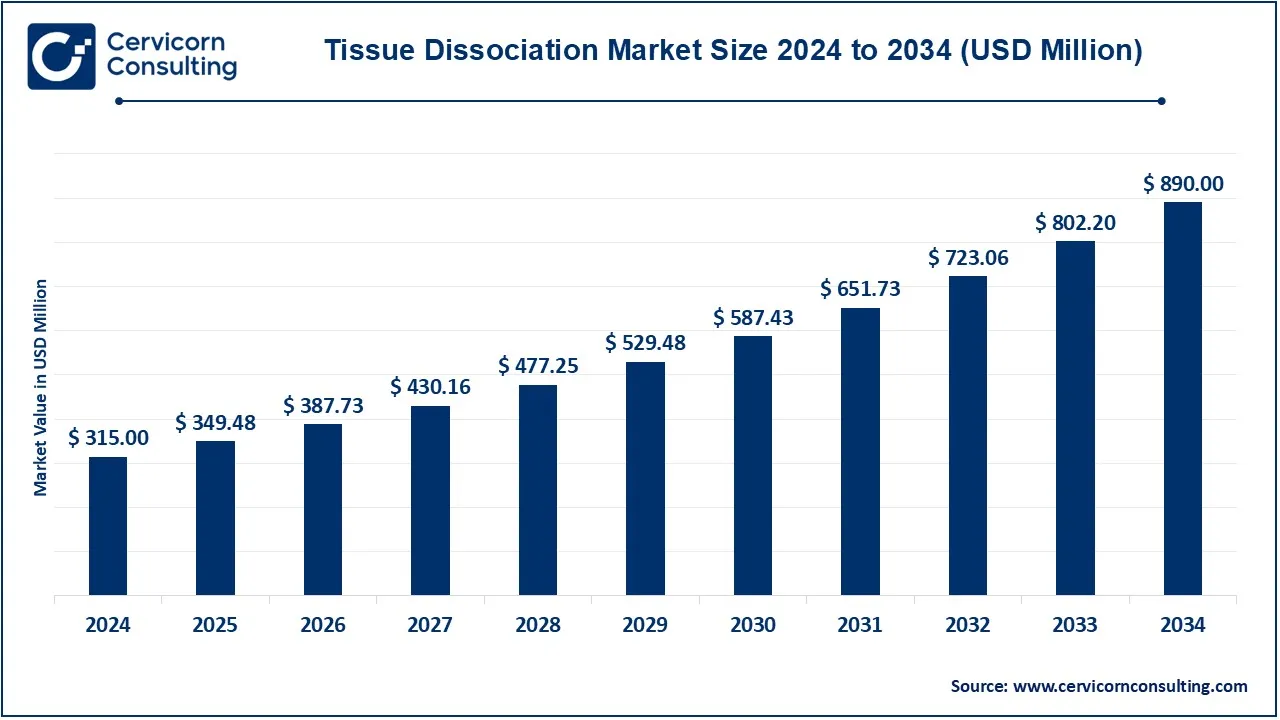Tissue Dissociation Market Overview
The global tissue dissociation market was valued at around USD 315 million in 2024 and is projected to reach approximately USD 890 million by 2034, growing at a CAGR of 10.94% between 2025 and 2034.
This market is categorized by product (enzymes, kits, automated tissue dissociators), application (cancer research, stem cell research, regenerative medicine, drug discovery & development), end user (pharmaceutical & biotechnology companies, research & academic institutes), and geography (North America, Europe, Asia‑Pacific, LAMEA – Latin America, Middle East & Africa).
Geographically, North America leads the market, followed by Europe, while Asia‑Pacific is the fastest-growing region. In 2024, North America accounted for approximately 37% of the revenue share, Europe around 29%, and Asia‑Pacific is expected to see rapid expansion throughout the forecast period.
Get a Free Sample: https://www.cervicornconsulting.com/sample/2495
Key Market Trends
Automation of Tissue Dissociation
The adoption of automated tissue dissociators is increasing as labs seek to reduce manual labor, enhance reproducibility, and boost throughput. High-throughput laboratories rely heavily on these systems to maintain consistency and efficiency.
Integration with Advanced Analytical Techniques
Tissue dissociation methods are now frequently paired with single-cell sequencing and high-throughput screening. Ensuring the isolation of viable, high-quality cells suitable for downstream applications is driving innovations in dissociation technologies.
Rise of Organoids and 3D Cell Culture Models
Organoids and 3D tissue models are increasingly used in drug screening, regenerative medicine, and disease modeling. Tissue dissociation is necessary both to generate organoids from tissues or pluripotent cells and to disaggregate them for analysis or subculturing.
Standardization of Protocols
Standardized kits and reagents are becoming more popular to ensure reproducibility and comparability of results across research labs and institutions.
Advances in Enzymatic Technologies
Enhanced enzyme formulations are improving cell yield and viability while minimizing cellular damage during dissociation. These innovations are particularly beneficial for tissues that are difficult to dissociate.
Market Drivers
-
Growing Oncology Research: The increasing need for high-quality tissue dissociation in cancer studies to examine tumor microenvironments, metastasis, biomarkers, and therapy testing.
-
Rising Prevalence of Chronic Diseases: Higher incidence of cancer, cardiovascular conditions, diabetes, and neurological disorders increases demand for cellular-level tissue research.
-
Technological Progress: Innovations in enzyme formulations, automated devices, and microfluidic technologies enhance efficiency, reproducibility, and cost-effectiveness.
-
Funding and Investment: Government and private sector support for biomedical research, regenerative medicine, and drug development fuels market adoption.
-
Demand for Personalized Medicine and Cell-Based Therapies: Precision medicine and cell therapy applications require robust tissue dissociation methods that maintain cell integrity for downstream use.
Quantitative Highlights:
-
Enzymes accounted for approximately 48.7% of the product segment revenue in 2024.
-
Pharmaceutical & biotechnology companies represented about 71.4% of end-user revenue in 2024.
-
The Asia‑Pacific market is projected to grow from USD 76.86 million in 2024 to over USD 217.16 million by 2034.
Impact of Trends and Drivers
By Product Segment:
-
Enzymes benefit from enhanced formulations and high demand in oncology and stem cell research.
-
Kits and automated systems gain from automation, protocol standardization, and integration with downstream processes like single-cell sequencing.
By Application:
-
Cancer research benefits from high-quality tissue dissociation for tumor and biomarker studies.
-
Stem cell research and regenerative medicine rely on maintaining viable cells.
-
Drug discovery demands reproducible dissociation for high-throughput applications.
By Region:
-
North America remains dominant due to advanced research infrastructure and high funding.
-
Europe follows with supportive funding, biotech clusters, and favorable regulations.
-
Asia‑Pacific is the fastest-growing market due to expanding research spending and rising disease burden.
-
LAMEA presents emerging opportunities but faces limitations in R&D budgets and regulatory frameworks.
Challenges & Opportunities
Challenges:
-
High cost of automated equipment and advanced enzymes limits adoption in smaller laboratories.
-
Skilled personnel are needed to operate advanced systems and optimize protocols.
-
Regulatory complexities in handling human and animal tissues may slow adoption.
-
Ensuring reproducibility and batch-to-batch consistency remains challenging across multiple labs.
Opportunities:
-
Personalized medicine and cell therapy create demand for robust, customizable dissociation solutions.
-
Emerging markets in Asia‑Pacific and LAMEA offer growth potential due to rising biotech investments.
-
Technological innovation in enzymes, automation, and microfluidic devices offers a competitive advantage.
-
Standardization initiatives enhance adoption and reproducibility across research centers.
Future Outlook
The tissue dissociation market is poised for continued strong growth, with a projected CAGR of 10.94% from 2025 to 2034. The market is expected to expand from USD 315 million in 2024 to roughly USD 890 million by 2034.
Key trends shaping the future market include:
-
Increased automation integrated with high-throughput workflows.
-
Development of tissue-specific enzyme formulations to maximize cell yield and viability.
-
Expansion in Asia‑Pacific and LAMEA regions due to growing research infrastructure.
-
Enhanced regulation and standardization for clinical and therapeutic applications.
-
Growth in regenerative medicine, organoids, disease modeling, and precision therapy applications.
📩 Contact for a Detailed Overview: https://www.cervicornconsulting.com/contact-us

